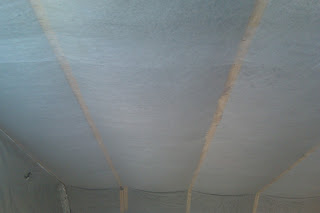

The last piece of the insulation puzzle is wet-spray cellulose's "poor relative", loose-fill cellulose. Loose-fill cellulose is made of up to 85% recycled paper and is sprayed dry with air, providing an R-value of 3.8 and blocking air leakage. Less expensive than both Icynene and wet-spray cellulose, our builder used it primarily in accessible, flat areas, sometimes using netting to hold it in place or offer support.
And the last piece of the insulation puzzle, would be fiberglass. To quote our builder, "in the inside walls for inexpensive sound insulation, that is the only place you will find fiberglass in one of my homes." He exaggerated a little, as he also used it (CertainTeed DRYRight) in the outside eaves, to form a barrier to spray the cellulose against. His opinion is that fiberglass is poorly suited to do its primary job, to provide insulation and to prevent air infiltration. To accomplish these tasks, the fiberglass must be installed perfectly, fitted precisely into all the nooks and crannies and sealed consistently around each and every opening and penetration. This is very time-consuming, labor intensive and challenging, as anyone who has attempted to apply fiberglass batt insulation can attest. It also tends to lose R-value across time and offers minimal thermal mass.


yeezy boost
ReplyDeletebirkenstock
polo ralph lauren outlet online
ugg boots
columbia sportswear
coach outlet
coach factory outlet
pittsburgh pirates jerseys
ugg outlet
gucci outlet
cc20181103